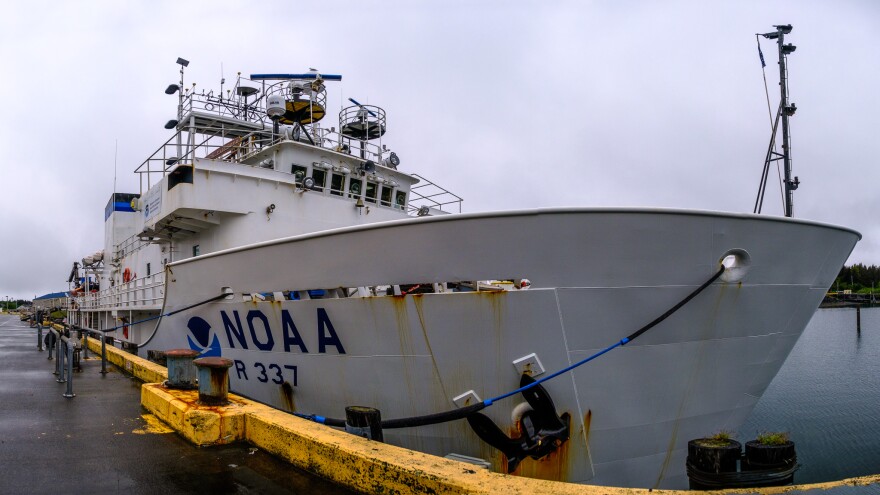An exploratory vessel that’s mapping the seafloor along Alaska’s coast docked in Kodiak last weekend. The crew of the Okeanos Explorer was in town to restock supplies before they went back to logging fault lines along the Aleutian Chain.
The Okeanos Explorer is operated by the National Oceanic and Atmospheric Administration. It’s in Alaska as part of an international effort called Seabed 2030 to map the entire sea floor by the end of the decade; the ship is one of a few vessels that’s part of the project.
Kasey Cantwell is the operations chief for NOAA ocean exploration and guides tours aboard the vessel. She said the crew discovers new things almost every time they launch an expedition.
“We have better maps of Mars than we do actually of our own Ocean,” Cantwell said. “We know so little about the deep sea. As a whole we know very little about the ocean – we’re still learning every day! But particularly the deep sea is largely unknown and unexplored.”
Colin Little is an officer of the NOAA Corps and captains the ship. The NOAA Corps is not a member of the United States Armed Forces, but is a member of the nation’s uniformed services.
Little has led the ship for 16 months. He said expeditions usually range between three to four weeks before they shore up to restock on food, like fruits and vegetables.
“Some of these places that we’re going are super far flung and hard to get to so there’s a lot of transit involved,” Captain Little said. “It’s just getting the most bang for our buck instead of getting there, being there for two days and coming back, let’s be there and stay there for 20 days.”
While they’re at sea, the crew has access to satellite internet anywhere. They use it to keep up with loved ones on land, but scientists also use that connection to publish their data for the public online.
Thomas Morrow is a physical scientist for NOAA. He’s part of the team that reads and compiles data as it’s published.
“Our website is updated daily,” he said. “So every day that we are out and we collect new information, that new data appears and you could actually watch our expeditions in real time.”
That new data could include information about any new species they find. Scientists also publish temperature data, as well as drafts of the seafloor maps they’re creating. Those maps are primarily generated via sonar that scan a spread of around 10 kilometers. But that isn’t their only tool – the Okeanos Explorer is also equipped with robots capable of diving about 6000 meters. That’s nearly 4 miles below the water’s surface or about as deep as Denali is tall.
One of the robots is about the size of a small car. It has arms to collect samples, as well as cameras and lights to find deep sea flora and fauna, or even explore caves on the ocean floor.
Cantwell, the vessel’s operations chief, said they never get tired of exploring and that it’s a dream job for anyone interested in careers in marine science.
“One day we’ll be diving on a shipwreck, the next day we’ll be on these beautiful coral gardens,” she said. “The next day will be a hydrothermal vent, the day after that we’ll be diving on a steep wall looking to see if there’s been any slope failures. It’s really truly incredible.”
The crew expects to finish their adventures in Alaska this fall. Their next expedition will take them to Hawaii next year.
This slideshow requires JavaScript.


